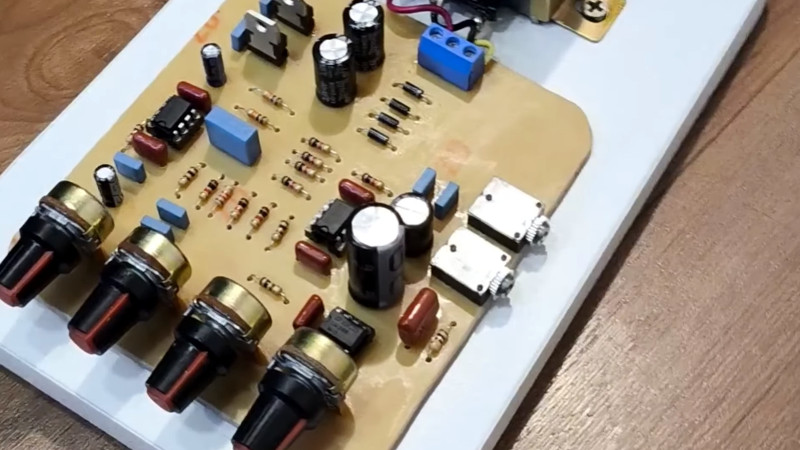Many years ago, audio equipment came with a tone control, a simple RC filter that would cut or boost the bass to taste. As time passed, this was split into two controls for bass and treble, and then finally into three for bass, mid, and treble. When audiophile fashion shifted towards graphic equalisers, these tone controls were rebranded as “3-band graphic equalisers”, a misleading term if ever we heard one. [Gabriel Dantas] designed one of these circuits, and unlike the simple passive networks found on cheap music centres of old, he’s doing a proper job with active filters.
The write-up is worth a read even if you are not in the market for a fancy tone control, for the basic primer it gives on designing an audio filter. The design contains, as you might expect, a low-pass, a bandpass, and a high-pass filter. These are built around TL072 FET-input op-amps, and an LM386 output stage is added to drive headphones.
The final project is built on a home-made PCB, complete with mains power supply. Audiophiles might demand more exotic parts, but we’re guessing that even with these proletarian components it will still sound pretty good. Probably better than the headphone amplifier featured in a recent project from a Hackaday writer, at least. There’s a build video, below the break.
















Just for additional info; I can’t yet find the exact page but there was a long ago article which explained that with treble and bass (baxandall) style equalisation a larger range of adjustment is possible.
This article touches on it.
https://www.duncanamps.com/technical/baxandall.html
This article.. I was close!
https://www.duncanamps.com/technical/tonestack.html
Your citations are comparing hifi tone controls to guitar tone controls.
Baxandall tone controls were invented in the days of tubes, and didn’t have the advantage of cheap gain that op-amps provide. The Baxandall design is lossy, which means the they’re likely to be noisy. Better tone control circuits are available today.
Bandaxalls can be implemented with op amps: https://sound-au.com/dwopa2.htm#s7
Noisiness depends on application but I agree that it’s not inherently a low-noise topology.
Should have used LM741. They’re good enough.
Author explicitly disagreed
“I had many LM741 amplifiers at home, so as a first option, I decided to use them. However, after some research, I found that this amplifier model is too noisy for audio applications”
Yet he didn’t find that the LM386 is too noisy.. 😕 But yeah, there’s no reason to use a LM741.
The TL07x series used are also pushing retirement age. I still use them in synth DIY stuff where you have +12/-12 rails, so the headroom isn’t that much of an issue.
But for general audio stuff, I really like the NE5532 these days. Rail-to-rail, and works with lower voltages. Give it a whirl.
I wrote this piece nearly a decade ago, and it’s still largely true for the simplicity and “loud enough on a 9V battery, sounds good enough for a crappy little speaker” category of projects.
https://hackaday.com/2016/12/07/you-can-have-my-lm386s-when-you-pry-them-from-my-cold-dead-hands/
But… it’s nice to have an amp chip that’ll drive the speaker in bridged mode if you’re using “modern” voltages.
For synths, having a bit of noise and cross-over distortion etc. can be a good thing. If you’re into the retrowave stuff, a simple sine wave slightly off-tune with a bit of shaped noise gives that wistful sound…
Let’s not forget the parametric EQ… 😉
There’s EQ up to 10 band in just about any player on a phone, but for portable live sound this is where it’s at.
Used to love the Baxandall for simplicity! Now it seems easier to go the DSP route and use Biquads configured as shelving filters.